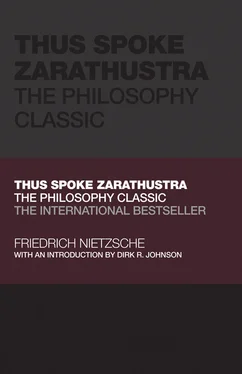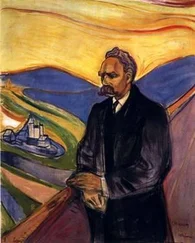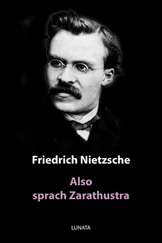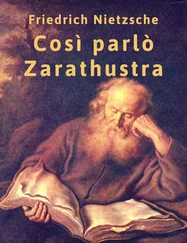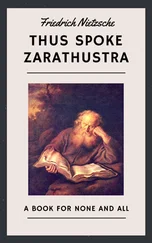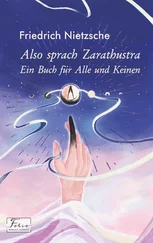Friedrich Nietzsche - Thus Spoke Zarathustra
Здесь есть возможность читать онлайн «Friedrich Nietzsche - Thus Spoke Zarathustra» — ознакомительный отрывок электронной книги совершенно бесплатно, а после прочтения отрывка купить полную версию. В некоторых случаях можно слушать аудио, скачать через торрент в формате fb2 и присутствует краткое содержание. Жанр: unrecognised, на английском языке. Описание произведения, (предисловие) а так же отзывы посетителей доступны на портале библиотеки ЛибКат.
- Название:Thus Spoke Zarathustra
- Автор:
- Жанр:
- Год:неизвестен
- ISBN:нет данных
- Рейтинг книги:5 / 5. Голосов: 1
-
Избранное:Добавить в избранное
- Отзывы:
-
Ваша оценка:
- 100
- 1
- 2
- 3
- 4
- 5
Thus Spoke Zarathustra: краткое содержание, описание и аннотация
Предлагаем к чтению аннотацию, описание, краткое содержание или предисловие (зависит от того, что написал сам автор книги «Thus Spoke Zarathustra»). Если вы не нашли необходимую информацию о книге — напишите в комментариях, мы постараемся отыскать её.
Thus Spoke Zarathustra: A Philosophy Classic, Thus Spoke Zarathustra: A Philosophy Classic
Thus Spoke Zarathustra — читать онлайн ознакомительный отрывок
Ниже представлен текст книги, разбитый по страницам. Система сохранения места последней прочитанной страницы, позволяет с удобством читать онлайн бесплатно книгу «Thus Spoke Zarathustra», без необходимости каждый раз заново искать на чём Вы остановились. Поставьте закладку, и сможете в любой момент перейти на страницу, на которой закончили чтение.
Интервал:
Закладка:
He suddenly catches sight of a reclining shepherd, who has a black snake lodged in his throat. He calls on the shepherd to rip it out, and he bites off its head and spits it out. The shepherd then stands up like a transformed being and laughs. That concludes Zarathustra's enigmatic riddle. It leaves the eternal return tantalizingly vague.
THE CONVALESCENT
In “The Convalescent,” Zarathustra presents the fullest (and only) articulation of his enigmatic concept, the eternal return. It is tempting to think that the first iteration presented within the riddle was its true expression. But Zarathustra was not yet in the position to call it forth. His encounter with the writhing shepherd was both a vision and a premonition – a premonition of his own future confrontation with the thought.
In “The Convalescent,” Zarathustra sees himself ready to face his greatest thought – “Up, abysmal thought, out of my depth!” The process of extracting the thought from his innermost being is so grueling and exhausting that he must recuperate for seven days. Only after he has recovered can he give voice to the experience.
Zarathustra attempts to convey his personal encounter with the thought of the eternal return. This time it is not a description of a concrete reality outside himself but the articulation of his subjective feelings (a thought ) toward an inner experience.
He conveys the thought that all signs of past greatness reveal a root pettiness, and that even the greatest are but small on closer inspection and will eternally return as small. Everything great fails to withstand closer scrutiny. Humankind does not progress or improve, but forever repeats the same pattern and produces the same types.
If the small eternally return and the great can no longer inspire, and if even past greatness conceals recurring human weakness, pettiness, and resentment, then that knowledge will cripple and suffocate. But by confronting the awareness and ripping it out, Zarathustra can move beyond it and incorporate it into his overall life affirmation.
It was latent disgust with life – specifically, his own life – that first inspired his ideal of a higher human type. But now his deeper insights into man have forced him to reconcile with life as it is and will always be.
THE SECOND DANCE SONG
In the penultimate section of Part Three, “The Second Dance Song,” Nietzsche again encounters the wily temptress, Life. Having internalized the thought of the eternal return, he has overcome the spirit of gravity that weighed him down. He can approach Life with greater confidence, and he now engages with her in a playful, bantering exchange. It is an exchange of equals, and wily Life chastises him for his brash attempt at mastery over her. She even envies his wisdom and fears he might leave her.
At the end of their encounter, Zarathustra accepts the boundaries that Life has drawn for them – a love that respects each other's freedom and independence – and affirms his relationship with her.
Nietzsche thus completes the main arc of his philosophical drama.
It started with an ambitious search to solve modern man's malaise. It concludes on a quiet, personal note. His protagonist Zarathustra has set aside his wisdom and learns to honor the mystery and inscrutability of life – and to find (temporary) joy and fulfillment in its sublime, transitory moments.
PART FOUR
There has been much scholarly speculation as to why Nietzsche appended a “fourth and final part” to Zarathustra .
He originally planned to conclude the text with Part Three, but decided to have Part Fourpublished privately. He had difficulty finding a publisher for it, but might also have considered the material too raucous, almost blasphemous, and therefore decided to limit its audience to friends.
Commentators have also expressed ambivalence about its literary qualities. Whereas the first three parts are composed in an elevated, lofty style, the tone of Part Fouris farcical, even slapstick. A likely model for it may have been the comic satyr play that followed the performance of a trilogy of Greek tragedies.
At the start of Part Four, a now aged Zarathustra encounters an assortment of “higher men” on his wanderings, including two kings, an old magician, and the pope, among others. Nietzsche even introduces an ass, which the figures end up worshipping. They take its braying to be a form of affirmation of the eternal return. Here Nietzsche parodies his greatest thought. He seems to want to warn against those who would turn his thought into a set doctrine or the basis for a substitute religion.
ZARATHUSTRA AND THE OVERCOMING OF PITY
Nietzsche offers textual evidence for his motivation for composing Part Four.
First among these are Zarathustra's opening passage to Part Four, his words in the second section “The Cry of Distress” as well as his concluding remarks in the final section (“The Sign”). He says: “O you higher men, your distress was it that the old soothsayer foretold to me yestermorn. Unto your distress did he want to seduce and tempt me.” He had also played with the idea of subtitling Part Four“The Temptation of Zarathustra,” which hints at the Soothsayer's attempt to seduce Zarathustra by evoking his pity.
Zarathustra indicates that overcoming pity of “higher types” is his ultimate challenge, his real proof of strength. By appealing to his innate pity for them, the soothsayer hoped to lure Zarathustra away from his Dionysian isolation and to throw him back into despair.
In the work's final section, “The Sign,” Zarathustra slips out of his cave in the early morning. His lion joins him. The lion roars and the remaining cast of characters scamper off. Zarathustra interprets this as a sign that his time has come. He recognizes that the cry of distress had been the soothsayer's trick all along to distract him from his higher calling. He declares his children are near and that the “noontide” will rise. He leaves the cave, “glowing and strong, like a morning sun.”
RECEPTION AND INTERPRETATION
The history of Zarathustra is in many ways the history of its reception. There have been numerous efforts to interpret this complex text, and it is only fitting it has eluded a definitive interpretation. This aura of mystery challenges each generation, and each individual reader, to find their own meaning in the work.
THE ÜBERMENSCH
Two strands of interpretation stand out. On one side, there has been a preoccupation with the notion of the Übermensch . Since Zarathustra declares this vision to be the new meaning of the earth and announces it in prophetic terms in the prologue, readers have expected that the entire text is meant to conceptualize and promote a future human ideal.
If one also considers that the work appeared during the dissemination of Darwin's findings and Zarathustra even seems to refer to a model of human evolution, it is understandable that many early commentators assumed Nietzsche had proposed an evolutionary ideal for humankind.
But Zarathustra is a literary work. It works with all the conventions and subtleties of narrative, and that requires us to be cautious and never to take at face value what it seems to promote. Even though Zarathustra proclaims the future of the Übermensch early in the prologue, he already distances himself by the end of it and suggests it will be a promise for only a select few.
Later in the text, the Übermensch almost disappears completely from view. The narrative then centers on the protagonist's personal crises and sets the stage for his impending encounter with the eternal return ( Parts Twoand Three). Significantly, the supposed visionary ideal rarely appears in the rest of Nietzsche's writings. This is surprising if one believes it to be a central premise of his philosophy.
Читать дальшеИнтервал:
Закладка:
Похожие книги на «Thus Spoke Zarathustra»
Представляем Вашему вниманию похожие книги на «Thus Spoke Zarathustra» списком для выбора. Мы отобрали схожую по названию и смыслу литературу в надежде предоставить читателям больше вариантов отыскать новые, интересные, ещё непрочитанные произведения.
Обсуждение, отзывы о книге «Thus Spoke Zarathustra» и просто собственные мнения читателей. Оставьте ваши комментарии, напишите, что Вы думаете о произведении, его смысле или главных героях. Укажите что конкретно понравилось, а что нет, и почему Вы так считаете.
